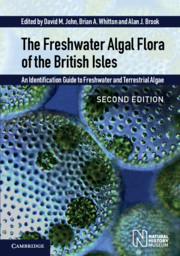 The Freshwater Algal Flora of the British Isles
The Freshwater Algal Flora of the British Isles Book contents
- Frontmatter
- Contents
- The online material (formerly provided in DVD format)
- List of Contributors
- Foreword
- Preface
- Acknowledgements
- Introduction
- Distribution and Ecology
- History of Freshwater Algal Studies in the British Isles
- Field Methods
- Laboratory Methods
- Water Framework Directive
- Cultures of British Freshwater Algae
- Classification
- Key to phyla
- Cyanobacteria (Cyanophyta)
- Phylum Rhodophyta (Red Algae)
- Phylum Euglenophyta (Euglenoids)
- Phylum Cryptophyta (Cryptomonads)
- Phylum Dinophyta (Dinoflagellates)
- Phylum Raphidophyta
- Phylum Haptophyta (Prymnesiophyta)
- Phylum Chrysophyta (Golden Algae)
- Phylum Xanthophyta (Tribophyta) (Yellow-Green Algae)
- Phylum Eustigmatophyta
- Phylum Bacillariophyta (Diatoms)
- Phylum Phaeophyta (Brown Algae)
- Primitive Green Algae (‘PRASINOPHYTA’)
- Phylum Chlorophyta (Green Algae)
- Phylum Glaucophyta
- Glossary
- Standard Form of Authors of Algal Names
- Sources of Illustrations or Material
- References
- Taxonomic Index
- Subject Index
- Plate Saction
- Miscellaneous Endmatter
- Miscellaneous Endmatter
Water Framework Directive
Published online by Cambridge University Press: 12 January 2024
- Frontmatter
- Contents
- The online material (formerly provided in DVD format)
- List of Contributors
- Foreword
- Preface
- Acknowledgements
- Introduction
- Distribution and Ecology
- History of Freshwater Algal Studies in the British Isles
- Field Methods
- Laboratory Methods
- Water Framework Directive
- Cultures of British Freshwater Algae
- Classification
- Key to phyla
- Cyanobacteria (Cyanophyta)
- Phylum Rhodophyta (Red Algae)
- Phylum Euglenophyta (Euglenoids)
- Phylum Cryptophyta (Cryptomonads)
- Phylum Dinophyta (Dinoflagellates)
- Phylum Raphidophyta
- Phylum Haptophyta (Prymnesiophyta)
- Phylum Chrysophyta (Golden Algae)
- Phylum Xanthophyta (Tribophyta) (Yellow-Green Algae)
- Phylum Eustigmatophyta
- Phylum Bacillariophyta (Diatoms)
- Phylum Phaeophyta (Brown Algae)
- Primitive Green Algae (‘PRASINOPHYTA’)
- Phylum Chlorophyta (Green Algae)
- Phylum Glaucophyta
- Glossary
- Standard Form of Authors of Algal Names
- Sources of Illustrations or Material
- References
- Taxonomic Index
- Subject Index
- Plate Saction
- Miscellaneous Endmatter
- Miscellaneous Endmatter
Summary
The Water Framework Directive (2000/60/EC) is the most significant piece of European water legislation for the protection, improvement and sustainable use of surface waters, transitional waters, coastal waters and groundwater across Europe (European Union, 2000). A key component of the Water Framework Directive (WFD) is the development of classification tools for determining the ecological status of surface waters, with the ecological status being divided into one of five classes (High, Good, Moderate, Poor or Bad). The aim is to ensure that all water bodies attain Good ecological status by 2015 (UKTAG, 2007). The class given to a particular water body represents an estimate of the degree to which the structure and functioning of the aquatic ecosystem supported by the water body have been altered by all the different pressures to which that water body is subject. This means that the results of classification will reflect the impacts of a much wider range of pressures on the water environment than do previous classification schemes.
The classification tools use a range of biological quality elements (BQEs), supported by measurements of physical and chemical determinands, hydrology and morphology. The algal community iswidely considered the first biological community to respond to eutrophication pressures and is the most direct indicator of all the BQEs of nutrient concentrations in the water (Carvalho et al., 2007). Excessive growths of phytoplankton are exacerbated by eutrophication, reducing the amenity and conservation value of affected sites. Moreover, cyanobacteria are arguably the most visible symptoms of eutrophication, with increasing frequencies and intensities of toxic cyanobacteria blooms resulting in numerous socio-economic problems. The algal tools are based on changes in the species composition and abundance of the algal flora in response to nutrient pressure. In the UK, separate ecological classification tools have been developed for phytobenthos (benthic diatoms) for standing waters (lochs/lakes) and rivers, although they share a common approach, and there is also a tool for phytoplankton in standingwaters (UKTAG, 2007). No ecological assessment is carried out in the UK using phytoplankton in rivers.
Sample collection for the Water Framework Directive
Sample collection methods are well standardized within the European Union. Benthic diatoms are collected during spring and autumn periods by brushing or scraping the upper surfaces of cobbles or small boulders from the river bed or from the littoral zones of lakes/lochs, in order to remove the biofilm.
- Type
- Chapter
- Information
- The Freshwater Algal Flora of the British IslesAn Identification Guide to Freshwater and Terrestrial Algae, pp. 24Publisher: Cambridge University PressPrint publication year: 2021


